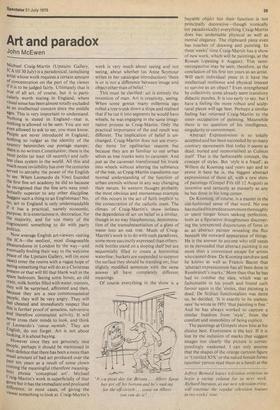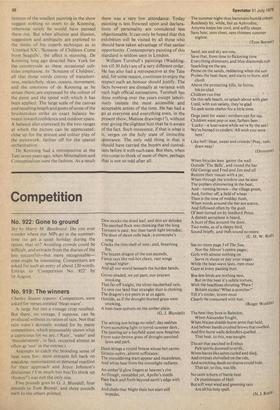Art and paradox
John McEwen
Michael Craig-Martin (Upstairs Gallery, ICA till 30 July) is a paradoxical, tantalising artist whose work requires a certain amount of concentration on the part of the viewer if it is to be judged fairly. Ultimately that is true of all art, of course, but it is particularly worth stating in England, where visual sense has been almost totally excluded as an intellectual concern since the middle ages. This is very important to understand. Nothing is stated in England—that is, nothing is allowed to be seen. You are not even allowed to ask to see, you must know. People are never introduced in England; nothing so vulgar as the identity of the country besmirches our postage stamps; there is no written Constitution; there is the Most polite (at least till recently) and ruthless class system in the world. All this and much more invisibility has over the centuries served to atrophy the power of the English to see. When Leonardo da Vinci founded the first fine art academy he did so because he recognised that the fine arts were intellectually superior to any other discipline. Suggest such a thing to an Englishman! No, no, art in England is only understandable if it has a practical, namely economic, Purpose. It is entertainme3t, decoration, for the majority, and for too many of the cognoscenti something to do with party Politics.
Now average English art-viewers visiting the icA—the seediest, most disagreeable Pleasuredome in London by the way—and eventually finding their way to the welcome Peace of the Upstairs Gallery, will (in most cases) enter the rooms with a vague hope of seeing something that will do as a Christmas Present or that will fill that blank wall in the spare bedroom. Seeing some boxes, an old crate, milk bottles filled with water, mirrors, they will be surprised, affronted and then, because they are a nice commonsensical People , they will be very angry. They will feel cheated and immediately suspect that this is further proof of senseless, subversive and therefore communist activity. It will never cross their minds to look, and think of Leonardo's 'causa mentale; They are English, do not forget. Art is not about looking, it is about buying. However since they are genuinely nice People, perhaps it should be mentioned in their defence that there has been a more than usual amount of bad art produced over the Past ten years as a result of some clown rAning the meaningful (therefore meaning Ss) phrase 'conceptual art'. Michael `raig-Martin's work is superficially of that genre but it has the immediate and profound difference, in most cases, of giving the viewer something to look at. Craig-Martin's
work is very much about seeing and not seeing, about whether (as Anne Seymour writes in her catalogue introduction) 'there is or is not a difference between image and object other than of belief.'
This must be clarified: art is entirely the invention of man. Art is creativity, seeing. When some genius many millennia ago rolled a tree trunk down a slope and realised that if he cut it into segments he would have wheels, he was engaging in the same imaginative process as Craig-Martin. Only the practical importance of the end result was different. The implication of belief is unchanged. Craig-Martin does not use everyday items for egalitarian reasons but because they are as familiar to our urban selves as tree trunks were to cavemen. And just as the caveman transformed his trunk into wheels without altering the substance of the tree, so Craig-Martin transforms our normal understanding of the function of urban utensils without in any way changing their nature. In western thought probably the most obvious and momentous example of this occurs in the act of faith implicit to the consecration of the catholic mass. The climax of Craig-Martin's show isolates the dependence Of art on belief in a similar, though in no way blasphemous, demonstration of the transubstantiation of a glass of water into an oak tree. Much of CraigMartin's work is to do with such paradoxes, some more succinctly expressed than others: milk bottles stand on a sloping shelf but are sequentially filled to create a horizontal waterline; buckets are suspended to support the surface they should be standing on; four slightly modified sentences with the same answer all have completely different meanings.
Of course everything in the show is a buyable object but their function is not principally decorative—though ironically (or paradoxically) everything Craig-Martin does has undeniable physical as well as mental elegance. The clipboard piece even has touches of drawing and painting. In three weeks' time Craig-Martin has a show of new work, which will be paintings, at the Rowan (opening 6 August). This semiretrospective may be seen, therefore, as the conclusion of his first ten years as an artist. Will each individual piece in it have the intellectual resilience and physical interest to survive as an object ? Even strengthened by collectivity some already seem transitory didactic puzzles. It is too early to say, but I have a feeling the more robust and sculptural pieces will age best. Perhaps a similar feeling has returned Craig-Martin to the sister occupation of painting. Meanwhile there is no question of his intelligence, singularity or commitment.
Abstract Expressionism is so totally accepted and has been succeeded by so many contrary movements that today it seems as dead, buried and memorialised as Cubism itself. That is the fashionable concept, the concept of styles. But 'style is a fraud', as Willem de Kooning said years ago and to prove it here he is, the biggest abstract expressionist of them all, with a new show of paintings (Gimpel Fits till 12 August) as inventive and certainly as masterly as any he has done in his long career.
De Kooning, of course, is a master in the old-fashioned sense of that word. No one has studied his predecessors more thoroughly or spent longer hours seeking perfection, both as a figurative draughtsman discovering the unexpected disjunctures of form or as an abstract painter revealing the flux beneath the outward appearance of things. He is the answer to anyone who still needs to be persuaded that abstract painting is no more than a convenient escape for artists who cannot draw. De Kooning can draw and he knows as well as Francis Bacon that 'abstract expressionism has all been done in Rembrandt's marks.' More than that he has had to combat the idea, which was so fashionable in his youth and found such favour again in the 'sixties, that painting is dead. De Stijlian functionalism was more so, he decided. 'It is exactly in its uselessness' he wrote in 1951 'that painting is free.' And he has always worked to capture a similar freedom from 'style', from the comfort and immobility of being explicit.
The paintings at Gimpels show him at his elusive best. Elusiveness is the key. If it is lost by the inclusion of marks that suggest images too clearly the picture is correspondingly weakened. I can only assume that the shapes of the orange cartoon figure in 'Untitled XIX' or the naked female forms (another person read them as a hand) at the
bottom of the smallest painting in the show suggest nothing so overt to de Kooning, otherwise surely he would have painted them out. But when allusion and illusion, suggestion and ambiguity are explored to the limits of his superb technique as in 'Untitled XX', 'Screams of Children Come from Seagulls', the effect is stunning. De Kooning long ago desuted New York for the countryside as these occasional subtitles emphasise. In 'Screams of Children', all that those words convey of transitoriness, melancholy, skies, oceans, movement, and the emotions of de Kooning as he senses them, are expressed by the colour of the paint and the speed with which it has been applied. The large scale of the canvas and resulting length and gusto of some of the brushstrokes strike an exact balance between inward confidence and outdoor space. A balance also expressed by the two ranges at which the picture can be appreciated: close up for the texture and colour play of the paintwork, farther off for the spatial orchestration.
De Kooning had a retrospective at the Tate seven years ago, when Minimalism and Conceptualism were the fashion. As a result
there was a very low attendance. Today painting is less frowned upon and declarations of personality are considered less objectionable. It can only be hoped that this exhibition will be visited by all those who should have taken advantage of that earlier opportunity. Contemporary painting of this standard is seldom seen in London.
William Turnbull's paintings (Waddington till 30 July) are of a very different order. He has also had a retrospective at the Tate and, for some reason, continues to enjoy the respect such an honour should justify. The facts however are dismally at variance with such high official estimations. Turnbull has done nothing over the years except laboriously imitate the most accessible and acceptable artists of the time. He has had a go at everyone and everything even, in the present show, Matisse drawings (!), without ever giving the slightest hint that he is aware of the fact. Such innocence, if that is what it is, verges on the holy state of invincible ignorance. The only odd thing is that it should have carried the buyers and custodians before it with such ease. But then, when you come to think of most of them, perhaps that is not so odd after all.



































 Previous page
Previous page